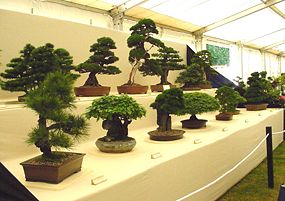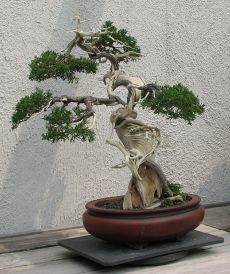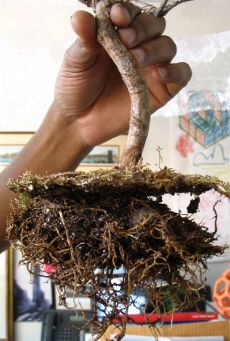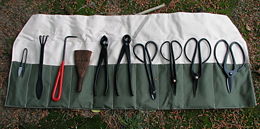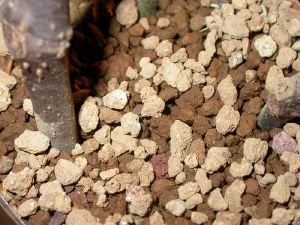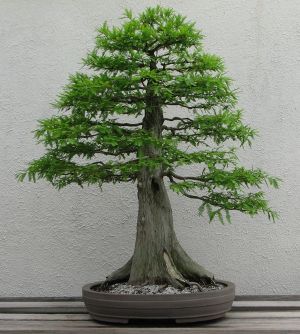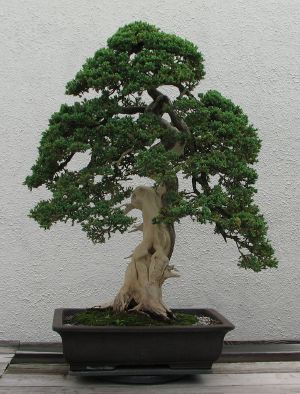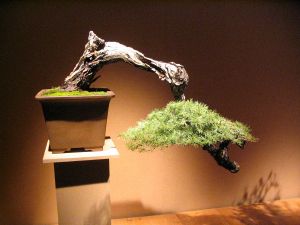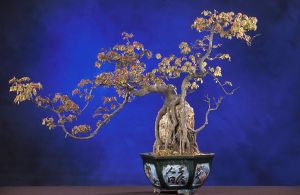Difference between revisions of "Bonsai" - New World Encyclopedia
MaedaMartha (talk | contribs) |
MaedaMartha (talk | contribs) |
||
| Line 1: | Line 1: | ||
| − | + | ||
{{otheruses}} | {{otheruses}} | ||
[[Image:Goshin, September 15, 2007.jpg|thumb|upright|[[John Naka]]'s masterpiece, ''[[Goshin]]'', is on display at the [[United States National Arboretum]].<ref name="Valavanis">William N. Valavanis, "[http://www.bonsai-wbff.org/nabf/newsletter1/1e.htm The History of Goshin (Protector of the spirit)]", North American Bonsai Federation Newsletter #1, Feature #5 (December 2002). Accessed April 1, 2008.</ref>]] | [[Image:Goshin, September 15, 2007.jpg|thumb|upright|[[John Naka]]'s masterpiece, ''[[Goshin]]'', is on display at the [[United States National Arboretum]].<ref name="Valavanis">William N. Valavanis, "[http://www.bonsai-wbff.org/nabf/newsletter1/1e.htm The History of Goshin (Protector of the spirit)]", North American Bonsai Federation Newsletter #1, Feature #5 (December 2002). Accessed April 1, 2008.</ref>]] | ||
| Line 198: | Line 198: | ||
[[tr:Bonsai]] | [[tr:Bonsai]] | ||
[[zh:盆景]] | [[zh:盆景]] | ||
| + | {{credits|Bonsai|210566007}} | ||
Revision as of 01:27, 7 May 2008
- For other uses, see Bonsai (disambiguation).

Bonsai listen ▶ (Japanese: 盆栽, literally "potted plant") is the art of aesthetic miniaturization of trees by growing them in containers. Cultivation includes techniques for shaping, watering, and repotting in various styles of containers.
Originating in China during the Han Dynasty, 'bonsai' is a Japanese pronunciation of the Chinese word penzai (盆栽). The word bonsai has been used in the West as an umbrella term for all miniature trees.
History
The origins of bonsai are believed to have begun nearly 2000 years ago during the Han Dynasty in China.[citation needed] It has since developed into new forms in parts of China, Japan, Korea and Vietnam.
At first, the Japanese used miniaturized trees grown in containers to decorate their homes and gardens.[2] During the Tokugawa period, landscape gardening attained new importance. Cultivation of plants such as azalea and maples became a pastime of the wealthy. Growing dwarf plants in containers was also popular. At this time, the term for dwarf potted trees was "a tree in a pot" (鉢の木 hachi-no-ki).
The c.1300 rhymed prose essay, Rhymeprose on a Miniature Landscape Garden, by the Japanese Zen monk Kokan Shiren, outlines the aesthetic principles for bonsai, bonseki and garden architecture itself.
The oldest known living bonsai trees are in the collection at Happo-en (a private garden and exclusive restaurant) in Tokyo, Japan, where bonsais are between 400 to 800 years old.[citation needed]
Cultivation
Bonsai are not genetically dwarfed plants. They can be created from nearly any tree or shrub species and remain small through pot confinement and crown or root pruning. Some specific species are more sought after for use as bonsai material because they have characteristics that make them appropriate for the smaller design arrangements of bonsai.
Techniques
The small size of the tree and the dwarfing of foliage result from pruning of both the leaves and the roots. Most trees require a dormancy period and do not grow roots or leaves at that time. Improper pruning can weaken or kill trees.[3]
Copper or aluminium wire wrapped around branches and trunks holds the branches in place until they lignify (convert into wood), usually 6-9 months or one growing season. Some species do not lignify strongly, or are already too stiff/brittle to be shaped and are not conducive to wiring, in which case shaping is accomplished primarily through pruning.[3]
Cultivators use deadwood features called jin and shari to simulate age and maturity in a bonsai. Jin is the term used when the bark from an entire branch is removed to create the impression of a snag of deadwood. Shari denotes stripping bark from areas of the trunk to simulate natural scarring from a broken limb or lightning strike.
Watering
With limited space in a bonsai pot, regular attention is needed to ensure the tree is correctly watered. Sun, heat and wind exposure can dry bonsai trees to the point of drought in a short period of time. While some species can handle periods of relative dryness, others require near-constant moisture. Watering too frequently, or allowing the soil to remain soggy, promotes fungal infections and root rot. Free draining soil is used to prevent waterlogging. Deciduous trees are more at risk of dehydration and will wilt as the soil dries out. Evergreen trees, which tend to cope with dry conditions better, do not display signs of the problem until after damage has occurred.
Repotting
Bonsai are repotted and root-pruned at intervals dictated by the vigour and age of each tree. In the case of deciduous trees, this is done as the tree is leaving its dormant period, generally around springtime. Bonsai are often repotted while in development, and less often as they become more mature. This prevents them from becoming pot-bound and encourages the growth of new feeder roots, allowing the tree to absorb moisture more efficiently.
Pre-bonsai material are often placed in "growing boxes" which are made from scraps of fenceboard or wood slats. These large boxes allow the roots to grow more freely and increase the vigor of the tree. The second stage, after using a grow box, has been to replant the tree in a "training box;" this is often smaller and helps to create a smaller dense root mass which can be more easily moved into a final presentation pot.
Wiring
Most bonsai are trained using malleable wire made from copper or copper colored aluminium. This is wrapped around the developing branches and trunk, allowing them to be moved into the desired shape and held in place by the wire. The tree is wired for at least one growing season to allow the branches to set in their new position. Some trees do not respond well to wiring and are shaped instead by pruning.
Tools
Special tools are available for the maintenance of bonsai. The most common tool is the concave cutter, a tool designed to prune flush, without leaving a stub. Other tools include branch bending jacks, wire pliers and shears of different proportions for performing detail and rough shaping.
Soil and fertilization
Opinions about soil mixes and fertilization vary widely among practitioners. Some promote the use of organic fertilizers to augment an essentially inorganic soil mix, while others will use chemical fertilizers freely. Bonsai soil is primarily a loose, fast-draining mix of components,[4] often a base mixture of coarse sand or gravel, fired clay pellets or expanded shale combined with an organic component such as peat or bark. In Japan, volcanic soils based on clay are preferred, such as akadama, or "red ball" soil, and kanuma, a type of yellow pumice used for azaleas and other calcifuges.
Location and overwintering
Most traditional bonsai are temperate climate trees and are kept outside all year. They require full sun in summer and usually a near-freezing dormancy period in winter. Depending on how hardy the tree species is, protection from very low temperatures may be required. Certain tropical species can survive winter without a dormancy period, and can therefore be kept indoors all year.
Containers
Bonsai pots have drainage holes typically covered with a plastic screen or mesh to prevent soil from escaping.
Containers come in a variety of shapes and colors and can be glazed or unglazed. Containers with straight sides and sharp corners are generally better suited to formally presented plants, while oval or round containers might be used for plants with informal shapes. Most evergreen bonsai are placed in unglazed pots, while deciduous trees are planted in glazed pots. It is important in design that the color of the pot compliments the tree. Some pots are highly collectible, such as ancient Chinese or Japanese pots made in regions with experienced pot makers such as Tokoname, Japan.
Common styles
In English, the most common styles include: formal upright, slant, informal upright, cascade, semi-cascade, raft, literati, and group/forest.
- The formal upright style, or Chokkan, is characterized by a straight, upright, tapering trunk. The trunk and branches of the informal upright style, or Moyogi, may incorporate pronounced bends and curves, but the apex of the informal upright is always located directly over where the trunk begins at the soil line.
- Slant-style, or Shakan, bonsai possess straight trunks like those of bonsai grown in the formal upright style. However, the slant style trunk emerges from the soil at an angle, and the apex of the bonsai will be located to the left or right of the root base.
- Cascade-style, or Kengai, bonsai are modeled after trees which grow over water or on the sides of mountains. The apex, or tip of the tree in the Semi-cascade-style, or Han Kengai, bonsai extend just at or beneath the lip of the bonsai pot; the apex of a (full) cascade style falls below the base of the pot.
- Raft-style, or Netsuranari, bonsai mimic a natural phenomenon that occurs when a tree topples onto its side (typically due to erosion or another natural force) and branches along the exposed side of the trunk, growing as if they are a group of new trunks. Sometimes, roots will develop from buried portions of the trunk. Raft-style bonsai can have sinuous, straight-line, or slanting trunks, all giving the illusion that they are a group of separate trees — while actually being the branches of a tree planted on its side.
- The literati style is characterized by a generally bare trunk line, with branches reduced to a minimum, and typically placed higher up on a long, often contorted trunk. This style derives its name from the Chinese literati, who were often artists, and some of whom painted Chinese brush paintings, like those found in the ancient text, The Mustard Seed Garden Manual of Painting, depicting pine trees that grew in harsh climates, struggling to reach sunlight. In Japan, the literati style is known as bunjin-gi (文人木). (Bunjin is a translation of the Chinese phrase wenren meaning "scholars practiced in the arts" and gi is a derivative of the Japanese word, ki, for "tree").
- The group or forest style, or Yose Ue, comprises a planting of more than one tree (typically an odd number if there are three or more trees, and essentially never 4 because of its significance in Japan) in a bonsai pot. The trees are usually the same species, with a variety of heights employed to add visual interest and to reflect the age differences encountered in mature forests.
- The root-over-rock style, or Sekijoju, is a style in which the roots of a tree (typically a fig tree) are wrapped around a rock. The rock is at the base of the trunk, with the roots exposed to varying degrees.
- The broom style, or Hokidachi is employed for trees with extensive, fine branching, often with species like elms. The trunk is straight and upright. It branches out in all directions about 1/3 of the way up the entire height of the tree. The branches and leaves form a ball-shaped crown which can also be very beautiful during the winter months.
- The multi-trunk style, or Ikadabuki has all the trunks growing out of one root system, and it actually is one single tree. All the trunks form one crown of leaves, in which the thickest and most developed trunk forms the top.
- The growing-in-a-rock, or Ishizuke style means the roots of the tree are growing in the cracks and holes of the rock. There is not much room for the roots to develop and take up nutrients. These trees are designed to visually represent that the tree has to struggle to survive.
Size classifications
| Class | Size | |||
|---|---|---|---|---|
| cm | in | |||
| tiny | Mame | Keshi-tsubu | up to 2.5 | up to 1 |
| Shito | 2.5 – 7.5 | 1–3 | ||
| small | Shohin | Gafu | 13 – 20 | 5–8 |
| Komono | up to 18 | up to 7.2 | ||
| Myabi | 15–25 | 6–10 | ||
| medium | Kifu | Katade-mochi | up to 40 | 16 |
| medium to large | Chu/Chuhin | 40–60 | 16–24 | |
| large | Dai/Daiza | Omono | up to 120 | up to 48 |
| Bonju | over 100 | over 40 | ||
Not all sources agree on exact range of size ranges. There are a number of specific techniques and styles associated with mame and shito sizes, the smallest bonsai.
Template:Spinout
The suitablity of any tree to being kept indoors is dictated by the plant's needs of light, temperature and humidity. The term indoor bonsai means that it is in a location outside its normal growing habitat, and would struggle to cope with its new location when outdoors. A tropical or sub-tropical species would be considered as indoor when located in a temperate climate area, just as a deciduous tree would be considered indoor in a tropical environment. This is because both would require artificial conditions to maintain good health.
Chinese Elm, Japanese black pine and Buddhist pine are common outdoor bonsai that can survive inside.[citation needed] Those who have successfully grown hardy specimens indoors have used a variety of techniques, such as having a cold room designated for bonsai and using the refrigerator. With indoor hardy bonsai, having proper lighting and the ability to give a cooling season are both necessary to ensuring survival.
Collecting
Bonsai may be developed from material obtained at gardening centers, or from material collected from the wild or urban landscape. Some regions have plant material that is known for its suitability in form - for example the California Juniper and Sierra Juniper found in the Sierra Mountains and the Bald Cypress found in the swamps of the Everglades.
ReferencesISBN links support NWE through referral fees
- ↑ William N. Valavanis, "The History of Goshin (Protector of the spirit)", North American Bonsai Federation Newsletter #1, Feature #5 (December 2002). Accessed April 1, 2008.
- ↑ http://www.arboretum.harvard.edu/plants/bonsai/intro.html Early American Bonsai: The Larz Anderson Collection of the Arnold Arboretum" by Peter Del Tredici, published in Arnoldia (Summer 1989) by Harvard University]
- ↑ 3.0 3.1 Lewis, Colin (2003). The Bonsai Handbook. Advanced Marketing Ltd.. ISBN 1-903938-30-9.
- ↑ It's All In The Soil by Mike Smith, published in Norfolk Bonsai (Spring 2007) by Norfolk Bonsai Association
See also
- Bonsai aesthetics
- Penjing — Chinese precursor to bonsai
- Saikei — gardens using bonsai
- Niwaki — Japanese art of tree pruning
- Mambonsai — pop culture twist on bonsai
- Indoor bonsai
- Topiary — western art of tree pruning
- List of organic gardening and farming topics
- List of species used in bonsai
- List of bonsai on stamps
Template:Japan-related topics
af:Bonsai ar:بونساي bg:Бонсай ca:Bonsai cs:Bonsaj da:Bonsai de:Bonsai et:Bonsai es:Bonsái eo:Bonsajo fa:بونسای fr:Bonsaï gl:Bonsai hr:Bonsai id:Bonsai it:Bonsai he:בונסאי hu:Bonszai mk:Бонсаи ml:ബോണ്സായി nl:Bonsai ja:盆栽 no:Bonsai pl:Bonsai pt:Bonsai ro:Bonsai ru:Бонсай simple:Bonsai sr:Бонсаи sh:Bonsai fi:Bonsai sv:Bonsai ta:பொன்சாய் vi:Bonsai tr:Bonsai zh:盆景
Credits
New World Encyclopedia writers and editors rewrote and completed the Wikipedia article in accordance with New World Encyclopedia standards. This article abides by terms of the Creative Commons CC-by-sa 3.0 License (CC-by-sa), which may be used and disseminated with proper attribution. Credit is due under the terms of this license that can reference both the New World Encyclopedia contributors and the selfless volunteer contributors of the Wikimedia Foundation. To cite this article click here for a list of acceptable citing formats.The history of earlier contributions by wikipedians is accessible to researchers here:
The history of this article since it was imported to New World Encyclopedia:
Note: Some restrictions may apply to use of individual images which are separately licensed.
